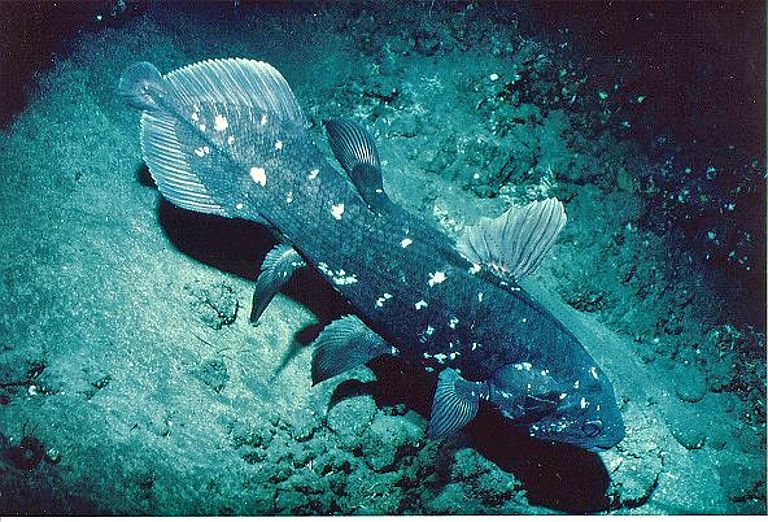Successful Paternity Test in Coelacanths
First time analysis of genetic material from pregnant females and juveniles
Until the middle of last century, scientists were convinced that the order of coelacanths (lobe-finned fish) became extinct around 60 million years ago. Only fossil records testified to the existence of these animals. Then, on 23 December 1938, fishermen discovered off the coast of South Africa a specimen of the supposedly extinct fish group which was accidentally caught in their net. Some 50 years later, the German biologist Professor Hans Fricke and his team, with the help of the submersible GEO, were able to film coelacanths for the first time in their natural environment in water depths of 200 meters off the Comoro Islands in the western Indian Ocean. Since then more than 300 live specimens, up to 1.90 m long and up to 100 kg in weight, have been documented. Yet many more mysteries about the prehistoric fish remain unsolved.
Now for the first time, researchers were able to perform molecular analyses of two gravid coelacanth females and their offspring. "This is truly special. Coelacanths are always caught by chance, and pregnant females are very rare. When it happens a team with the necessary expertise must be immediately present to take the tissue samples," says biologist Karen Hissmann from GEOMAR Helmholtz Centre for Ocean Research Kiel. She and her colleagues Jürgen Schauer and Hans Fricke have been investigating oelacanths for many years, using the GEO-successor JAGO, Germany's only manned research submersible. The team is one of the leading experts in coelacanth research.
Together with colleagues from Mozambique and Zanzibar, they were able to take samples from locally caught coelacanth females and their unborn juveniles. Both females were apparently close to giving birth soon. One had ended up in a fishing trawler’s net, and the other was caught in a gill net which was set by local fishermen for shark fishing at a depth of about 150 m.
Scientist Dr. Kathrin Lampert of the Ruhr-University Bochum and Prof. Dr. Manfred Schartl, University of Würzburg, examined the samples for their genetic characteristics and conducted a microsatellite analysis. This technique is also used for paternity tests in humans. Microsatellites are short DNA segments, consisting of only a few sequences that typically repeat themselves up to 50 times. Usually they do not carry genetic information but are inherited from both parents.
"Because we knew the genotype of the mother, we were able to clearly show by microsatellite analysis that each coelacanth clutch had only one single father," says Professor Schartl in summarizing the key findings of the study. It appears that fertile coelacanth females mate with only one male. Why they behave like this is unclear because multiple mating could increase the chance of successful fertilization. It would also ensure a high level of genetic diversity. It could be, however, that the energy expense needed to search for mates and the risks of falling prey to predators during mating outweigh these benefits. Whether coelacanth females behave permanently or only seasonally monogamous remains a yet unanswered question.
In many fish species, fertilization of the eggs takes place outside of the mother’s body. The female release their eggs into the water, and then the males - which can be several - add their sperm. The usually very numerous offspring then grow up without any female nurishment or parental care. Coelacanths, however, give birth to fully developed young, fertilization of the eggs by the male takes place inside the body of the female. According to estimates by scientists, the "pregnancy" lasts about three years. The two broods studied consisted of 26 and 23 embryos.
Also known as "living fossil", recent coelacanths are morphological very similar to their fossil ancestors of which some are more than 300 million year old. Beside lungfish, coelacanths are evolutionary close to the transition of aquatic and land-living vertebrates. They are therefore of great importance for evolutionary biology. Very recently, a worldwide network of scientists was able to decode the entire genome of the coelacanth.
Original publication:
Lampert, KP, K. Blass, K. Hissmann, J. Schauer, P. Shunula, Z. el Kharousy, BP Ngatunga, H. Fricke, M. Schartl (2013): Single male paternity in coelacanths. Nature Communications, http://dx.doi.org/10.1038/ncomms3488
Images in higher resolution:
Upon request from presse(at)geomar.de
Contact:
Jan Steffen (GEOMAR, Communication ] Media), Phone: +49-431 600-2811, jsteffen(at)geomar.de



